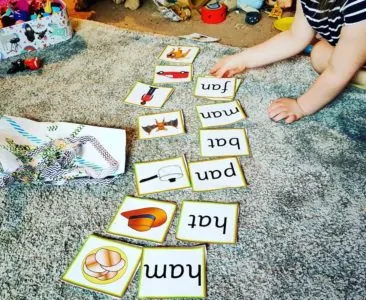You love getting lost in a good story, but your child treats books like frisbees. Or maybe you were never a bookworm yourself, but you want to ensure your little one has an easier time in school than you did.
Whatever your motivation, raising a reader is one of the best gifts you can give your child. We will break down practical tips to foster a love for literature, explain how kids actually learn to read, and help you navigate the bumps along the way.
Key Takeaways
- Start early: Reading to infants builds bonding, language skills, and emotional intelligence.
- Make it interactive: Use funny voices, ask questions, and follow your child’s interests rather than sticking to a rigid list.
- Understand the methods: Schools often use a mix of Phonics (decoding sounds) and Sight Words (pattern recognition).
- Keep it fun: Never force reading when a child is frustrated; focus on pre-literacy skills like the alphabet and rhyming first.

Start Reading During Infancy
It is never too early to crack open a book. You can start reading to your baby the day you bring them home from the hospital. Here is why starting early matters (1):
- It creates a comforting bonding ritual full of snuggles.
- It prepares their brain for independent reading years down the road.
- It exposes them to varied vocabulary and sentence structures.
- It teaches them about emotions through your tone and facial expressions.
Manage Your Expectations
Your newborn won’t understand the plot of the story, and that is okay. They are listening to the rhythm of your voice and watching your face. This is a great time to read whatever you want out loud. Catch up on your favorite blog or a novel while they soak in the benefits of reading.
Don’t aim for a marathon session. As a new parent, you barely have time to shower, let alone read War and Peace. Aim for just a few minutes at a time to keep it manageable (2).
If you want to introduce kid-specific books, look for high-contrast images or colorful board books. Just be prepared for your baby to ignore the story and try to eat the book instead.
Pro Tip
Strategies To Build Reading Habits
You know reading is important, but sometimes it feels like a chore. If your efforts are stalling, try these 10 tips to make books exciting again.
1. Engage With Open-Ended Questions
Don’t just read the words; talk about them. If your child is reading, stop and ask what they think will happen next.
Kids aren’t always great at summaries, so be patient if their explanation of the plot is long-winded and confusing. Even if you are mentally checking your grocery list, stay tuned in. If you are reading to a younger child, pause to look at the pictures. Ask, “Why do you think the bear looks sad?” This builds comprehension skills and keeps them focused.
2. Create A Family Book Club
Read the same book as your older child. It gives you common ground and something new to talk about at dinner. Comparing notes on characters or predicting the ending can be a huge bonding experience.
3. Offer Diverse Reading Options
If your child hates reading, they might just hate the books they have access to. Introduce age-appropriate books in different genres. Maybe they dislike fantasy but would love a non-fiction book about sharks.
Ensure the difficulty level is right. If a book is too hard, they will get frustrated. If it is too easy, they will get bored.
4. Follow Their Passions
Leverage their obsessions. If you have a kid who loves dinosaurs, fill their shelf with T-Rex encyclopedias and prehistoric adventures. Take them to the library and let them pull every book off the shelf that catches their eye, even if it isn’t what you would choose.
5. Model Good Reading Habits
Kids mimic what they see. If you spend all your downtime scrolling on your phone, they will want to do that too. Let them catch you reading a magazine or a novel. Just 15 minutes of “monkey see, monkey do” can instill a lifelong habit.
6. Slow Down The Pace
Don’t rush through the bedtime story just to get back to Netflix. Kids can sense when you are checking the clock. If you treat reading like a nuisance, they will view it as a chore. Try to be present and enjoy the cuddle time.
7. Establish A Daily Routine
Life is busy, and reading often gets pushed aside for homework, baths, or sports. To make it stick, you have to prioritize it. Whether it is 20 minutes before bed or 10 minutes after breakfast, consistency is key.
8. Embrace The Repetition
You might scream if you have to read Green Eggs and Ham one more time. We get it. But repetition is how children learn language patterns and build confidence. If they want the same book for 30 nights in a row, suck it up and read it with a smile. They will eventually move on, and you might actually miss it.
9. Keep Books Accessible Everywhere
Stash books in the car, the diaper bag, and the bathroom. This lets you sneak in a story while waiting at the doctor’s office or sitting in the school pick-up line. Reading doesn’t have to be a formal event at a desk; it fits into the cracks of the day.
10. Bring Stories To Life
Show them the fun side of literature. Use silly voices for different characters, make loud sound effects, and use big facial expressions. If you are having fun, they will too.
Understand How Kids Learn To Read
Watching a child decode words for the first time is magical, but the process can be stressful for parents. You might worry they are falling behind or wonder which teaching method is best. Here is a breakdown of the two main approaches.
Phonics
Phonics is the gold standard for teaching reading. It focuses on the relationship between letters and sounds (decoding). Children learn that the letter “B” makes a “buh” sound, and they blend sounds together to form words.
Pros
- It gives kids the tools to sound out words they have never seen before.
- It significantly helps with spelling skills.
Cons
- It can be boring or repetitive for some kids.
- English has many rule-breaking words that can’t be sounded out easily (like “ocean” or “rough”) (3).
Look and Say (Whole Language)
This method relies on pattern recognition and memorization. Instead of breaking a word down, children are taught to recognize the word as a whole image. This is often how kids learn “sight words” using flashcards.
Pros
- It helps children quickly learn irregular words that defy phonics rules.
- It can build reading speed (fluency) faster in the very beginning.
Cons
- If a child encounters a word they haven’t memorized, they have no tools to figure it out.
- It relies heavily on memory rather than understanding the structure of language.
Most modern schools use a balanced approach, leaning heavily on phonics for the foundation while using sight words for high-frequency irregular words.
Troubleshoot Common Struggles
Learning to read is hard work. When your child gets frustrated, they might shut down. Here is how to keep the momentum going:
- Comfort them: If they are crying over a difficult book, close it. Cuddle them and try again later.
- Build confidence: Remind them of other hard things they learned, like riding a bike or tying shoes.
- Praise effort: Focus on how hard they are trying, not just whether they got the word right.
Avoid Pressure Before Kindergarten
It is great to introduce reading before kindergarten, but do not force it. If your child isn’t reading independently before the first day of school, do not panic. They are not “behind.”
Instead of drilling flashcards, focus on pre-literacy skills. Before kindergarten, it is helpful if they know:
- The alphabet song.
- How to hold a book and turn pages (left to right).
- How to recognize their own name.
- The names of at least 10 letters (4).
Expect Fluency In First Grade
Most children start reading independently by the end of first grade. However, there is a wide range of “normal.” Some kids pick it up at 4; others click at 7. If you are concerned, talk to their teacher. They can tell you if your child needs extra support or if they are just on their own timeline.
Support Without Hovering
When your child starts reading to you, it is a proud moment. Don’t ruin it by being a helicopter editor.
- Correct gently: If they mispronounce a word, don’t laugh. Gently help them sound it out.
- Be patient: It might take them a long time to get through a sentence. Don’t finish the sentence for them unless they ask for help.
- Celebrate: Tell them how much you love hearing their voice. Positive reinforcement works wonders.









